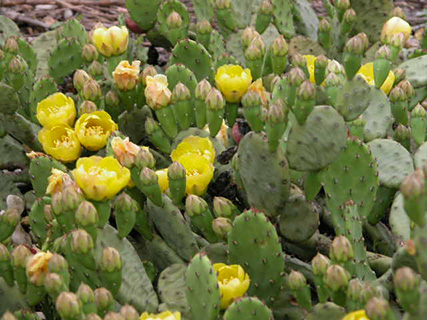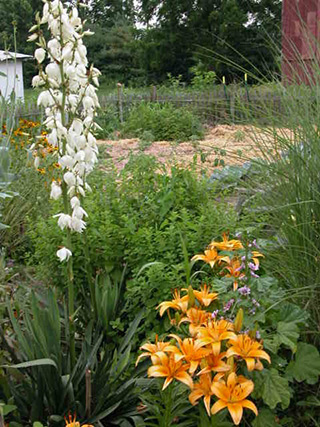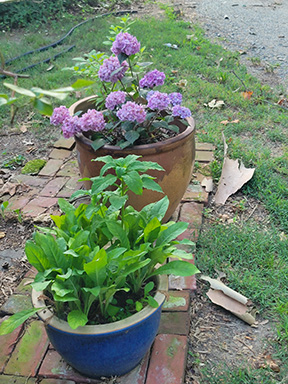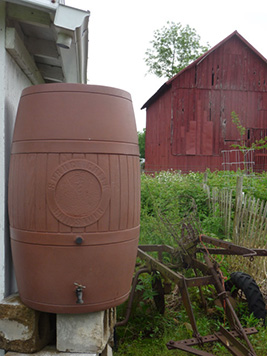Despite the reprieve from the recent three-day scorcher, we are likely to have repeats throughout the summer with an added bonus of drought.
“Climate Change is impacting everything from habitat restoration to land management and invasive plant treatment,” says Kathy Thornton, Natural Lands Project Field Technician at Washington College’s Center for Environment & Society. “And it has impacts on wildlife and plant establishment, too.”
So, what’s a gardener (or any human being) to do? There are both short-term and longer-term strategies that can help. Most people have heard the basics, beginning with increasing their individual landscape’s complement of native plants – particularly native ecotypes, which have evolved in this region along with their pollinators and other interdependent species. Established natives tend to be tougher and lower maintenance than non-natives, especially long term. But even natives need attention initially.
“Native plants are often touted as being more adapted – and they are,” notes Thornton. “But in pots and when they’re getting established, they need water. Once established, they are awesome in terms of creative, resilient landscape.”
So, choosing natives is one strategy. Another is adding shade, which mitigates ambient air temps.
“Planting a small tree on the south side of your house or creating a more forested landscape can really make a difference,” says Thornton. (On a 95-degree Fahrenheit day, I’ve measured as much as a seven-degree difference in temp between the sundrenched veg garden and the shaded back yard). Until newly planted trees grow, a temporary canopy of shade cloth, which is used for greenhouses in summer, can help prevent sun scald on tender plants. It can also slightly cool a space in general while allowing rain penetration.
In addition, think: Right plant; right place – long a gardening mantra. Thoughtful location improves survival rate and lowers water needs. For example, full sun perennial beds call for something approaching xeriscape plants i.e. natives that are almost desert-adapted.
“There are natives like Yucca or even Prickly Pear (Opuntia) that don’t require as much water, so it’s less work for the gardener,” says Thornton, “and they still offer ecosystem value and are beautiful, too.”
Other tough-as-nails sun-loving natives include Yarrow (Achillea millefolium), False Indigo (Baptisia), Black-eyed Susan (Rudbeckia) and Purple Coneflower (Echinacea) that, once established, can take a licking and keep on ticking.
Another strategy – aka being sensible – is to plant in early morning or late afternoon not in the midday sun. (Mad dogs and Englishmen come to mind). Then, water wisely. Consider soil composition (sandy? Or loamy with better moisture retention?), weather conditions – drying wind sucks as much as 25% of the plant’s water from its leaves – and the plant’s root system i.e., how robust and deep each plant’s roots are. Each will be a factor in planting and watering.
“You need to consider how deep you want that water to percolate,” says Miri Talabac, Horticulture Coordinator at UMD Extension HGIC, noting that getting it down to the deepest roots without waterlogging the soil helps plant resilience.
“People tend to over-irrigate in frequency and under-irrigate in terms of timing and depth. If you water too often and not deep enough, it encourages shallow roots, which makes them more vulnerable to drought.”
Talabac urges people to regularly check soil moisture at a depth of 6 inches with fingers, trowel, or screwdriver rather than watering on a set schedule. “Other than feeling the soil, you don’t want to wait until it wilts,” she says. “Plants have to have enough water to draw nutrients in as well as making sure they don’t get scorched. When plants are too drought-stressed, the stomates [microscopic leaf pores] close, and they pause photosynthesizing.”
Water in early morning. Watering in the evening allows water to sit on leaves which can encourage fungal diseases, and watering during the day increases water lost to evaporation by as much as 40%. Drip and soaker hoses can help prevent excessive evaporation, and therefore save on the water bill – or the well pump, whichever.
Another strategy is to install rain barrels, which capture rainwater for later use. Plus, the water retains a tiny bit of the nitrogen that rainwater collects on its journey to earth. (And their use is a recommended Bay-Wise practice). Once properly installed, they benefit the garden and gardener (and environment) for years.
Another strategy that people sometimes forget is mulch, which helps to smother water-thieving weeds, conserves soil moisture and moderates soil temps, which helps to keep roots from frying. There are several good choices for mulch – undyed wood chips, bark, leaf mulch (from your own fallen leaves last fall), newspaper, and straw. (Dyed mulch is usually more expensive than natural and can leach chemicals into the soil). Straw, which is neutral in pH is helpful in vegetable beds. And some people have great results with green mulch.
“We have a carpet of violets,” says Thornton. “They’ve just kinda come in, but they are a beautiful ground cover, and it serves as a living mulch that helps to keep everything from baking.”
And Thornton reminds us to add a fresh water source for animals, who often perish in drought.
“Whether it’s a bird bath, which is well maintained, or something else,” she says. (Mosquito Dunks in the birdbaths or other standing water kill mosquito larvae without harming anything else, including dragonflies, are relatively inexpensive and a snap to use). Thornton has a small pond with moving water in their shaded back yard. “We have birds attracted to the little fountain in our pond, who bath in it,” she says. Lovely.
There’s a wealth of native plants available now, and the more we request, the more garden centers and nurseries will respond. The Maryland Native Plant Society (MNPS) and the beautifully laid out and illustrated US Fish and Wildlife Service’s Native Plants for Wildlife Habitat and Conservation Landscaping can help with plant choices.
“There are so many beautiful native shrubs and understory plants that create this sanctuary that’s beautiful but really ecologically important, too,” says Thornton.
See Kathy Thornton at the MNPS September 6&7 conference at Washington College, open to both members and non-members.
To register:
Vascular Plants of Maryland
https://cdn.wildapricot.com/29048/resources/Publications/VascularPlantsofMD.pdf
UMD Extension page: Watering trees and shrubs: adaptable to native perennials and annuals.
https://extension.umd.edu/resource/watering-trees-and-shrubs/
The Water-Smart Garden: Techniques and Strategies for Conserving, Capturing, and Efficiently Using Water in Today’s Climate by Noelle Johnson. (Cool Springs Press, 2025)
All photos by Nancy Taylor Robson. Lead photo is Opuntia in bloom.
Longtime journalist and essayist Nancy Taylor Robson is also the author of four books: Woman in The Wheelhouse; award-winning Course of the Waterman; A Love Like No Other: Abigail and John Adams, a Modern Love Story; and OK Now What? A Caregiver’s Guide to What Matters, which she wrote with Sue Collins, RN.






Write a Letter to the Editor on this Article
We encourage readers to offer their point of view on this article by submitting the following form. Editing is sometimes necessary and is done at the discretion of the editorial staff.